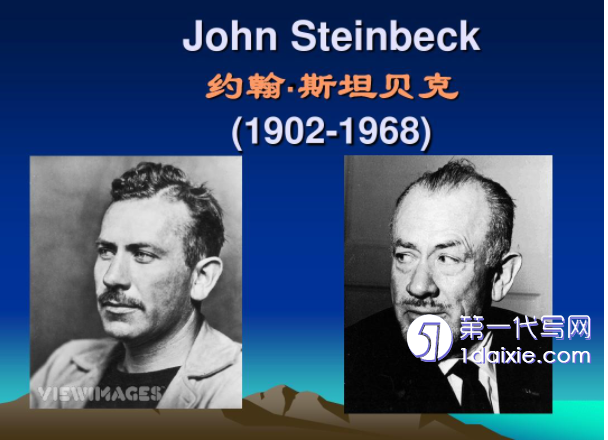本文是一篇英语论文,本研究认为多重文学空间的转换与并置,呈现了斯坦贝克以对工人群体关系的哲学思考,揭示了工人群体力量的颠覆性,构建了一条重建工人主体性的合理路径。
Chapter One Literature Review and Theoretical Framework
1.1 Overseas Studies on John Steinbeck’s Labor Trilogy

Overseas studies of Steinbeck are controversial, with the first monograph appearing a decade after he won the Nobel Prize for Literature. Contemporaneous critics, on the one hand, considered Steinbeck a writer of popular literature, whose works were revolutionary, and whose studies of his work hardly escaped the influence of the political climate. One example is Edmund Wilson, a leading figure in American literary criticism. This situation lasted from the early 1940s to the late 1950s. The study of Steinbeck consciously avoided social criticism with the publication of Peter Lisca’s The Wide World of John Steinbeck in 1958. The persistent disagreement over Steinbeck’s work has created the “Steinbeck problem” in the academy, which explores the reasons for the critical judgment of Steinbeck and his work. In the 1980s, Steinbeck's California regional authorship gained prominence. Currently, the main research topics on the study of John Steinbeck revolve around feminism, ecocriticism,his “phalanx theory”, history and culture.
As the first published work in the trilogy, In Dubious Battle has received relatively less attention than the other two. Influenced by the previous novel, Tortilla Flat, In Dubious Battle was often compared to its predecessor upon its publication. John Chamberlain argued that “it is undeniable that Mr. Steinbeck has written a novel that is as exciting as Tortilla Flat was genuinely warming” (Chamberlain, 1996:55). In addition, the book's depiction of the strike has led critics to focus their studies on the social criticism of the novel, focusing on the social context in the novel, as well as its connection to John Milton’s Paradise Lost and the mythological metaphors. In Joseph Eddy Fontenrose’s critical book John Steinbeck: An Introduction and Interpretation, he analyzed the archetypal scenes of the counterpart myth in In Dubious Battle (Fontenrose, 1963). Seven years after the novel's publication, Carlos Baker argues that there is a psychological perspective beneath the surface social level of the novel, and “At the psychological level the novel takes on parabolical significance” (Baker, 1996:69). Research around the strike in the novel has continued, with Jon Falsarella Dawson, a lecture of the University of North Georgia Athens, taking the strike in the novel as an entry point to analyze the roots of human suffering in the background of society.
1.2 Domestic Studies on John Steinbeck’s Labor Trilogy
Although Steinbeck's works were translated into Chinese as early as the 1940s, domestic research on Steinbeck has been less than that of his contemporaries Hemingway and Faulkner. The domestic research on Steinbeck could be divided into three main stages. The first stage began in 1940 when Steinbeck's work The Grapes of Wrath was translated into Chinese. This stage started from the perspective of social criticism, and most of the studies focused on The Grapes of Wrath, one of John Steinbeck's labor trilogy. Most literary critics analyzed Steinbeck's concern for the working class, to study the author's political ideology, resulting in the ignorance of the literary and artistic value of his works. The second stage, from the 1950s to the end of the 20th century, focuses on the analysis of Steinbeck's works from the perspective of Marxist criticism, as well as the introduction of the author's life and works. The attitude of Dong Hengxun, a famous Steinbeck researcher in the last century, changed from initial praise to a critical attitude at a later stage, which represented the ups and downs of Steinbeck's reputation in domestic research. He has also analyzed the reasons for the declining trend in Steinbeck's research, arguing that it is mainly related to “non-literary factors” (Dong Hengxun, 1996:32). In the 21st century, with the diversification of literary criticism, the philosophical views, literary and artistic values, and literary contexts of Steinbeck and his works have gradually received the attention of literary critics, which also leads to the innovation of research perspectives on his labor trilogy.
Chapter Two The Roots of the Labor Dilemma: The Spatial Crisis in Labor Trilogy
2.1 Fragmentation of Physical Space Resulted from Industrialization
The environment in the labor trilogy revolves around the natural landscape, the city, and Highway 66. The transformation of the physical space in all its dimensions by means of industrialization is based on a system of exploitation of the laborers. The control of space by capitalists has led to excessive disparities in wealth distribution, creating extreme polarization in the lives of the population. At the same time, disputes over the demand for land worsened the survival situation of laborers. “Ownership of the land becomes the eminent right of a monarch, the symbol of order and action” (Lefebvre, 2003: 9). Capitalists and ranchers incessantly occupied land resources and exploited the land. The destruction of the natural environment by industrialization's expansion confronted migrant laborers with a new survival dilemma. Cities and highways, which carry the flow of capital, also continue to encroach on the living space of laborers.
2.1.1 Fragmentation of Natural Physical Space
Steinbeck was a writer “who placed a great deal of value in the environment and the natural world” (Morretta, 2015:92), and there are many depictions of natural space in the labor trilogy, and the natural elements of land, in particular, are an important driving force in the development of the novel's plot. The natural physical space is not only the setting of the novel or the geographical place in which the storyline takes place. The natural space in the labor trilogy no longer occupies an objectified position, but is embodied with more vitality.
2.2The Mental Space Dilemma Caused by Mobility
The labor trilogy presents the life oppression faced by laborers during the Great Depression and the confusion about their future life. Migrant laborers were the occupation that most laborers were forced to choose around the 1930s. Their jobs lacked stability and they needed to migrant from farm to farm in search of suitable job opportunities. With the rapid development of capitalism, great changes had taken place in the different industries, including the agricultural industry. The traditional agricultural farming industry has changed the previous methods of cultivation and gradually transformed into the modernization of agriculture. The emergence of railroads, roads, and various modern means of transportation produced the new national space which created convenience for human beings, and made it easier for laborers to move around looking for jobs. However, such mobility destroys the stability of laborers’ lives. Laborers' spatial practice experience was an incomplete experience acquired in the mobility controlled by capital. This kind of spatial experience causes a crisis of mental space for both the laborers’ group and individuals. Mobility in space is closely related to political ideology. “It controls flows and it controls agglomerations” (Lefevre, 1991:388). Political ideology in space determines the labor's mobility trends. The destination of laborers' movement, and the direction of their lives, are influenced by political ideology. The mobility that spatial studies scholars are concerned with is more profoundly elucidated in the book Mobility by the British sociologist John Urry at the beginning of 21st century. Mobility is not the same as physical movement but movement imbued with meaning, history and ideology. By considering the mobility of the migrant laborers, the spatial and cultural connotations in labor trilogy could be explored, and thus grasp the causes of laborers’ mental space dilemmas.
Chapter Three Deprivation of Subjectivity: The Suffering of Laborers in Labor Trilogy ............................ 31
3.1 Oppression of Laborers by Unbalanced Physical Space Division ................ 31
3.1.1 Exploitation of Laborers' Living Space ........................... 31
3.1.2 Deprivation of the Rights to Land Ownership .................................... 34
Chapter Four From Subversion to Reconstruction: The Power of Group in Labor Trilogy .......................... 44
4.1 Subversive Power from the Labor Group ............................ 44
4.2 Commitment in the Face of Tragedy ............................. 48
Conclusion .......................... 55
Chapter Four From Subversion to Reconstruction: The Power of Group in Labor Trilogy
4.1 Subversive Power from the Labor Group

The social critique focusing on Steinbeck and his focus on the laborers always emphasizes Steinbeck's desire to pursue equality for laborers in a revolutionary way. Steinbeck, however, is more concerned with the existential plight faced by laborers, the fact that they are exploited. The narratives in the labor trilogy are not propagating a sense of revolution. The revolution that the laborers revolted against could have been defeated under the larger social circumstance, as the battle remains dubious in In Dubious Battle. The literary space presented in the novel explores the crisis and oppression of laborers in that space, while also delving into the subversive power of the laborers' community.
Steinbeck interpreted the relationship between individuals and groups in terms of phalanx theory. His theory takes a view from our perspective, specifically from the "I" to the "we" perspective. Groups have the soul and the direction. Although they are composed of individuals, they have different properties. In the context of historical events, groups can do things that individuals are not capable of. The power of the group can drive the development of society, and the combined power of the group is beyond the accumulation of individual power and could change the individual. And the survival of the individual depends on the group.
Conclusion
Based on Lefebvre's critical theory of space, this thesis makes a systematic interpretation of the multiple spaces in the labor trilogy—In Dubious Battle, Of Mice and Men and The Grapes of Wrath—exploring the widespread existential problems imposed on the laborers. The spatial theory provides more openness to the interpretation of the works, which is helpful to obtain a deep understanding of the literary space in Steinbeck's novels and grasp the diachronic literary thought of the creation process of Steinbeck's labor trilogy, instructive to a deeper exploration of Steinbeck's creation idea deeply.
Throughout the analysis of three spaces—physical, mental and social, the hardships of the life of the laborers are revealed out of the capitalist exploitation and the disintegration of their subjectivity. The superficial contradictions in the trilogy contain the root cause of the crisis of laborers' living space. Institutional and ideological inequalities are attached to the means of industrialized expansion, occupying the living space of laborers, eroding their mental space, and continuously marginalizing their social status.
reference(omitted)
